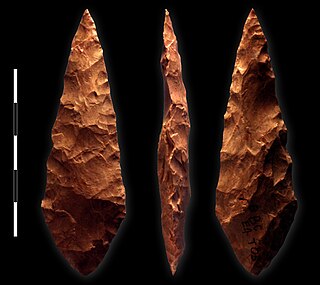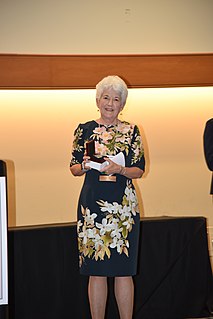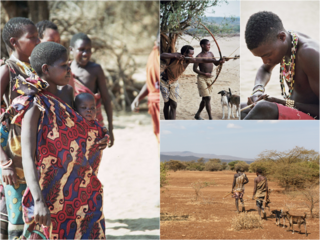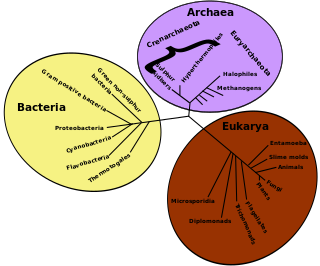
A hunter-gatherer is a human living in a society in which most or all food is obtained by foraging. Hunter-gatherer societies stand in contrast to agricultural societies, which rely mainly on domesticated species.

The Oldowan was a widespread stone tool archaeological industry (style) in prehistory. These early tools were simple, usually made with one or a few flakes chipped off with another stone. Oldowan tools were used during the Lower Paleolithic period, 2.6 million years ago up until 1.7 million years ago, by ancient Hominin across much of Africa, South Asia, the Middle East and Europe. This technological industry was followed by the more sophisticated Acheulean industry.

Evolutionary anthropology is the interdisciplinary study of the evolution of human physiology and human behaviour and the relation between hominids and non-hominid primates. Evolutionary anthropology is based in natural science and social science. Various fields and disciplines of evolutionary anthropology are:

The grandmother hypothesis is a hypothesis to explain the existence of menopause in human life history by identifying the adaptive value of extended kin networking. It builds on the previously postulated "mother hypothesis" which states that as mothers age, the costs of reproducing become greater, and energy devoted to those activities would be better spent helping her offspring in their reproductive efforts. It suggests that by redirecting their energy onto those of their offspring, grandmothers can better ensure the survival of their genes through younger generations. By providing sustenance and support to their kin, grandmothers not only ensure that their genetic interests are met, but they also enhance their social networks which could translate into better immediate resource acquisition. This effect could extend past kin into larger community networks and benefit wider group fitness.

Colin Peter Groves was a British-Australian biologist and anthropologist. Groves was Professor of Biological Anthropology at the Australian National University in Canberra, Australia.

Meave G. Leakey is a British paleoanthropologist. She works at Stony Brook University and is co-ordinator of Plio-Pleistocene research at the Turkana Basin Institute. She studies early hominid evolution and has done extensive field research in the Turkana Basin. She has Doctor of Philosophy and Doctor of Science degrees.
The term Plio-Pleistocene refers to an informally described geological pseudo-period, which begins about 5 million years ago (mya) and, drawing forward, combines the time ranges of the formally defined Pliocene and Pleistocene epochs—marking from about 5 mya to about 12 kya. Nominally, the Holocene epoch—the last 12 thousand years—would be excluded, but most Earth scientists would probably treat the current times as incorporated into the term "Plio-Pleistocene"; see below.

Tim D. White is an American paleoanthropologist and Professor of Integrative Biology at the University of California, Berkeley. He is best known for leading the team which discovered Ardi, the type specimen of Ardipithecus ramidus, a 4.4 million-year-old likely human ancestor. Prior to that discovery, his early career was notable for his work on Lucy as Australopithecus afarensis with discoverer Donald Johanson.

Glynn Llywelyn Isaac was a South African archaeologist who specialised in the very early prehistory of Africa, and was one of twin sons born to botanists William Edwyn Isaac and Frances Margaret Leighton. He has been called the most influential Africanist of the last half century, and his papers on human movement and behavior are still cited in studies a quarter of a century later.

The Middle Stone Age was a period of African prehistory between the Early Stone Age and the Later Stone Age. It is generally considered to have begun around 280,000 years ago and ended around 50–25,000 years ago. The beginnings of particular MSA stone tools have their origins as far back as 550–500,000 years ago and as such some researchers consider this to be the beginnings of the MSA. The MSA is often mistakenly understood to be synonymous with the Middle Paleolithic of Europe, especially due to their roughly contemporaneous time span, however, the Middle Paleolithic of Europe represents an entirely different hominin population, Homo neanderthalensis, than the MSA of Africa, which did not have Neanderthal populations. Additionally, current archaeological research in Africa has yielded much evidence to suggest that modern human behavior and cognition was beginning to develop much earlier in Africa during the MSA than it was in Europe during the Middle Paleolithic. The MSA is associated with both anatomically modern humans as well as archaic Homo sapiens, sometimes referred to as Homo helmei. Early physical evidence comes from the Gademotta Formation in Ethiopia, the Kapthurin Formation in Kenya and Kathu Pan in South Africa.

Jisk'a Iru Muqu is a pre-Columbian archaeological site 54 kilometers (34 mi) south-east of Puno, Peru. The site lies in the mountains at elevation 4,115 meters (13,500 feet), in the Aymara community of Jachacachi, adjacent to the Ilave River drainage, of the Lake Titicaca Basin, Peru. Occupation of Jisk'a Iru Muqu spans from the Late Archaic to the Formative.
Environmental anthropology is a sub-specialty within the field of anthropology that takes an active role in examining the relationships between humans and their environment across space and time.
The sexual division of labour (SDL) is the delegation of different tasks between males and females. Among human foragers, males and females target different types of foods and share them with each other for a mutual or familial benefit. In some species, males and females eat slightly different foods, while in other species, males and females will routinely share food; but only in humans are these two attributes combined. The few remaining hunter-gatherer populations in the world serve as evolutionary models that can help explain the origin of the sexual division of labor. Many studies on the sexual division of labor have been conducted on hunter-gatherer populations, such as the Hadza, a hunter-gatherer population of Tanzania.
Hominid dispersals in Europe refers to the colonisation of the European continent by various species of hominid, including hominins and archaic and modern humans.

Robert Laurens Kelly is an American anthropologist who is a Professor at the University of Wyoming. As a professor, he has taught introductory Archaeology as well as upper-level courses focused in Hunter-Gathers, North American Archaeology, Lithic Analysis, and Human Behavioral Ecology. Kelly’s interest in archaeology began when he was a sophomore in high school in 1973. His first experience in fieldwork was an excavation of Gatecliff Rockshelter, a prehistoric site in central Nevada. Since then, Kelly has been involved with archaeology and has dedicated the majority of his work to the ethnology, ethnography, and archaeology of foraging peoples, which include research on lithic technology, initial colonization of the New World, evolutionary ecology of hunter-gatherers, and archaeological method and theory. He has been involved in research projects throughout the United States and in Chile, where he studied the remains of the Inca as well as coastal shell middens, and Madagascar, where in order to learn about farmer-forager society, Kelly has participated in ethnoarchaeological research. A majority of his work has been carried out in the Great Basin, but after moving to Wyoming in 1997 he has shifted his research to the rockshelters in the southwest Wyoming and the Bighorn Mountains.
Sabine Gaudzinski-Windheuser is a German archaeologist. She is a Professor at the Johannes Gutenberg-University, Mainz and Director of the Monrepos Archaeological Research Centre and Museum for human behavioural Evolution of the Römisch-Germanisches Zentralmuseum at Monrepos Castle in Neuwied, Germany.

Anna Katherine "Kay" Behrensmeyer is an American taphonomist and paleoecologist. She is a pioneer in the study of the fossil records of terrestrial ecosystems and engages in geological and paleontological field research into the ecological context of human evolution in East Africa. She is Curator of Vertebrate Paleontology in the Department of Paleobiology at the Smithsonian Institution's National Museum of Natural History (NMNH). At the museum, she is co-director of the Evolution of Terrestrial Ecosystems program and an associate of the Human Origins Program.
Evolutionary psychology has traditionally focused on individual-level behaviors, determined by species-typical psychological adaptations. Considerable work, though, has been done on how these adaptations shape and, ultimately govern, culture. Tooby and Cosmides (1989) argued that the mind consists of many domain-specific psychological adaptations, some of which may constrain what cultural material is learned or taught. As opposed to a domain-general cultural acquisition program, where an individual passively receives culturally-transmitted material from the group, Tooby and Cosmides (1989), among others, argue that: "the psyche evolved to generate adaptive rather than repetitive behavior, and hence critically analyzes the behavior of those surrounding it in highly structured and patterned ways, to be used as a rich source of information out of which to construct a 'private culture' or individually tailored adaptive system; in consequence, this system may or may not mirror the behavior of others in any given respect.".
Evolutionary biologists have developed various theoretical models to explain the evolution of food-sharing behavior—"the unresisted transfer of food from one food-motivated individual to another"—among humans and other animals.
Erella Hovers is an Israeli paleoanthropologist. She is currently a professor at The Hebrew University of Jerusalem, working within the Institute of Archeology. The majority of her field work is centered in the Horn of Africa, with a primary focus on Ein Qashish, Israel and Eastern Ethiopia. Her research concentrates on the development of the use of symbolism during the Levantine Middle Palaeolithic and Middle Stone Age. Other research interests include lithic technology, taphonomy, and general behavior of early hominids..



















